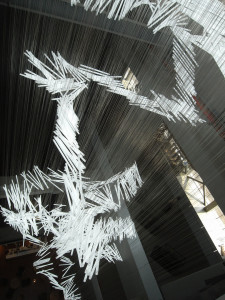Shanghai Biennale 2012 第九届上海双年展 / Reactivation 重新发电
Curator: Qiu Zhijie 邱志杰 / October 2012 – March 2013
 Well, the Shanghai Biennale 2012 has been quite a disaster this year, but I feel that all the complaining has been already done by other parties. I almost feel sorry for Qiu Zhijie, the chief curator… Can he be really blamed for all the problems? Qiu went on pointing his fingers at the museum management responsible for the delay in the building construction and to a lack of funds. Maybe his intentions were good… but it was the execution where it all went wrong.
Well, the Shanghai Biennale 2012 has been quite a disaster this year, but I feel that all the complaining has been already done by other parties. I almost feel sorry for Qiu Zhijie, the chief curator… Can he be really blamed for all the problems? Qiu went on pointing his fingers at the museum management responsible for the delay in the building construction and to a lack of funds. Maybe his intentions were good… but it was the execution where it all went wrong.
Given the issues this Biennale faced, I feel it is hard to review it as a whole. From walking through the show, I could not really follow the pre-announced topics. There were interesting works on display, but it was more of a treasure hunt. The main victims of all the Biennale issues were the artists, whose work was good, but it was on many occasions crippled by installation problems. I decided to write only a few paragraphs, focusing rather on the location itself than the actual contents. In addition to that, I am planning to highlight a number of individual artworks or city pavilions that touched me in one way or another in separate posts.
The main location of the Biennale – the so called Power Sation of Art – is an impressive building. Seeing the building which used to be a power plant, standing close to the banks of Huangpu river, one cannot but think of the very likely inspiration and aspiration: The Tate Modern on the banks of river Thames in London. Based on the announcements, this building should indeed become the Chinese version of Tate Modern – the first public museum of contemporary art in mainland China. So far, I can attest that the building is there and standing, and the inaugural show – the Shanghai Biennale 2012 – in on show at the moment. What the future will bring – let’s see. But I have to admit I am already haunted by the image of yet another big empty building inChina that calls itself a ‘museum’. My only remark for now is on the interiors, which are big and clean, but they have been furbished in a factory style rather than in a gallery style. For example, one would not expect to see a big red fire hydrant in between two artworks on display.
In addition to the Power Station, the Biennale had another ambitious section devoted to city pavilions. It was plagued by the same execution problems as the main show, but in contrast to the main show, it was visible that cities had completely free hands to work on their pavilions. This resulted in a very variable quality of the city pavilion shows, which ranged from completely laughable to good. The freedom given to the cities also allowed some self (help) initiative. Some city pavilions managed to make up for the overall management shortcomings. I am guessing this was mainly due to the city pavilion team’s personal effort.
The idea of city pavilions itself is not bad, but the problem was quality control. It should be the role of the curator to select good artworks, or in the case of city pavilions good city pavilion curators. While it is interesting to see art from different part of the world, what counts in the end of the day is the quality of the artwork.
The pavilions were strewn around the central pedestrian area of Nanjing East Road, mostly in a strip of houses due for renovation – an industrial ruin type of setting. This is not necessarily a bad thing, and the location on Nanjing East Roadwas excellent. This was a great opportunity to bring art closer to people.
A few more city pavilions were located in the already renovated Rockbund real estate property (same block as the Rockbund Art Museum). These pavilions were mostly disappointments, but I’m not able to say whether that was due to the overall management failure, the city pavilion teams lack of initiative, or the Rockbund real estate management.
If you live in Shanghai or have a free afternoon while passing through, the Biennale is still worth a visit, but I would not recommend flying or riding to Shanghai to see it. Visiting the show needs a very calm approach, and one has to be prepared for disappointments in the form of artworks that are installed very badly, not working or even missing. If one overcomes the difficulties, there are some gems to be discovered.
